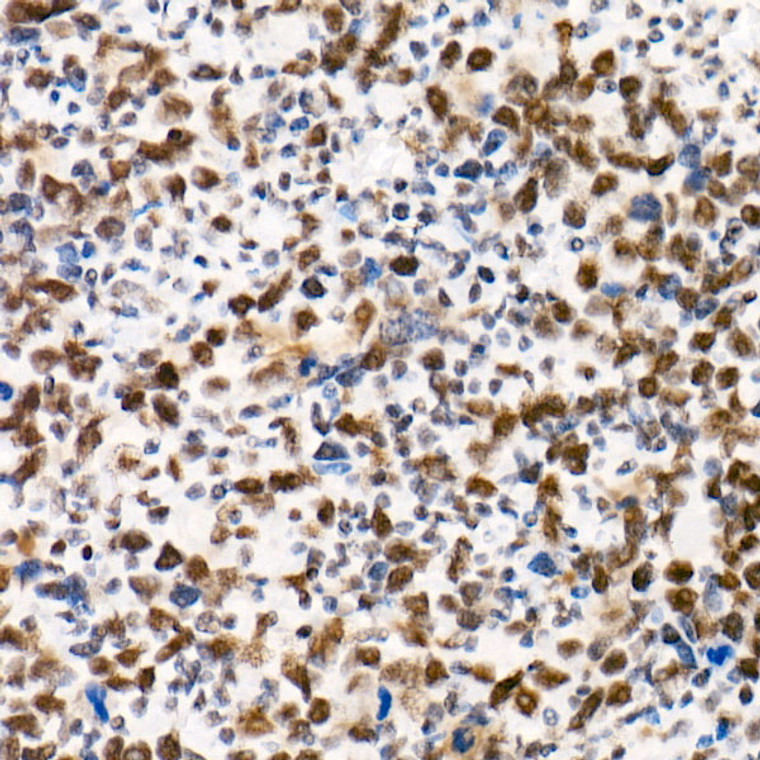| Host: |
Rabbit |
| Applications: |
WB/IHC |
| Reactivity: |
Human/Mouse/Rat |
| Note: |
STRICTLY FOR FURTHER SCIENTIFIC RESEARCH USE ONLY (RUO). MUST NOT TO BE USED IN DIAGNOSTIC OR THERAPEUTIC APPLICATIONS. |
| Short Description: |
Rabbit monoclonal antibody anti-SNF5 (50-150) is suitable for use in Western Blot and Immunohistochemistry research applications. |
| Clonality: |
Monoclonal |
| Clone ID: |
S1MR |
| Conjugation: |
Unconjugated |
| Isotype: |
IgG |
| Formulation: |
PBS with 0.05% Proclin300, 0.05% BSA, 50% Glycerol, pH7.3. |
| Purification: |
Affinity purification |
| Dilution Range: |
WB 1:1000-1:5000IHC-P 1:50-1:200 |
| Storage Instruction: |
Store at-20°C for up to 1 year from the date of receipt, and avoid repeat freeze-thaw cycles. |
| Gene Symbol: |
SMARCB1 |
| Gene ID: |
6598 |
| Uniprot ID: |
SNF5_HUMAN |
| Immunogen Region: |
50-150 |
| Immunogen: |
A synthetic peptide corresponding to a sequence within amino acids 50-150 of human SMARCB1/SNF5 (NP_003064.2). |
| Immunogen Sequence: |
LWRRLATVEERKKIVASSHG KKTKPNTKDHGYTTLATSVT LLKASEVEEILDGNDEKYKA VSISTEPPTYLREQKAKRNS QWVPTLPNSSHHLDAVPCST T |
| Function | Core component of the BAF (hSWI/SNF) complex. This ATP-dependent chromatin-remodeling complex plays important roles in cell proliferation and differentiation, in cellular antiviral activities and inhibition of tumor formation. The BAF complex is able to create a stable, altered form of chromatin that constrains fewer negative supercoils than normal. This change in supercoiling would be due to the conversion of up to one-half of the nucleosomes on polynucleosomal arrays into asymmetric structures, termed altosomes, each composed of 2 histones octamers. Stimulates in vitro the remodeling activity of SMARCA4/BRG1/BAF190A. Involved in activation of CSF1 promoter. Belongs to the neural progenitors-specific chromatin remodeling complex (npBAF complex) and the neuron-specific chromatin remodeling complex (nBAF complex). During neural development a switch from a stem/progenitor to a postmitotic chromatin remodeling mechanism occurs as neurons exit the cell cycle and become committed to their adult state. The transition from proliferating neural stem/progenitor cells to postmitotic neurons requires a switch in subunit composition of the npBAF and nBAF complexes. As neural progenitors exit mitosis and differentiate into neurons, npBAF complexes which contain ACTL6A/BAF53A and PHF10/BAF45A, are exchanged for homologous alternative ACTL6B/BAF53B and DPF1/BAF45B or DPF3/BAF45C subunits in neuron-specific complexes (nBAF). The npBAF complex is essential for the self-renewal/proliferative capacity of the multipotent neural stem cells. The nBAF complex along with CREST plays a role regulating the activity of genes essential for dendrite growth. Plays a key role in cell-cycle control and causes cell cycle arrest in G0/G1. |
| Protein Name | Swi/Snf-Related Matrix-Associated Actin-Dependent Regulator Of Chromatin Subfamily B Member 1Brg1-Associated Factor 47Baf47Integrase Interactor 1 ProteinSnf5 HomologHsnf5 |
| Database Links | Reactome: R-HSA-3214858Reactome: R-HSA-8939243 |
| Cellular Localisation | Nucleus |
| Alternative Antibody Names | Anti-Swi/Snf-Related Matrix-Associated Actin-Dependent Regulator Of Chromatin Subfamily B Member 1 antibodyAnti-Brg1-Associated Factor 47 antibodyAnti-Baf47 antibodyAnti-Integrase Interactor 1 Protein antibodyAnti-Snf5 Homolog antibodyAnti-Hsnf5 antibodyAnti-SMARCB1 antibodyAnti-BAF47 antibodyAnti-INI1 antibodyAnti-SNF5L1 antibody |
Information sourced from Uniprot.org
12 months for antibodies. 6 months for ELISA Kits. Please see website T&Cs for further guidance













![Western blot analysis of various lysates using [KO Validated] IRF3 Rabbit monoclonal antibody (STJ11101781) at 1:1000 dilution. Secondary antibody: HRP Goat Anti-Rabbit IgG (H+L) (STJS000856) at 1:10000 dilution. Lysates/proteins: 25 Mu g per lane. Blocking buffer: 3% nonfat dry milk in TBST. Detection: ECL Basic Kit. Exposure time: 3min. Western blot analysis of various lysates using [KO Validated] IRF3 Rabbit monoclonal antibody (STJ11101781) at 1:1000 dilution. Secondary antibody: HRP Goat Anti-Rabbit IgG (H+L) (STJS000856) at 1:10000 dilution. Lysates/proteins: 25 Mu g per lane. Blocking buffer: 3% nonfat dry milk in TBST. Detection: ECL Basic Kit. Exposure time: 3min.](https://cdn11.bigcommerce.com/s-zso2xnchw9/images/stencil/300x300/products/90696/360781/STJ11101781_1__59011.1713125500.jpg?c=1)